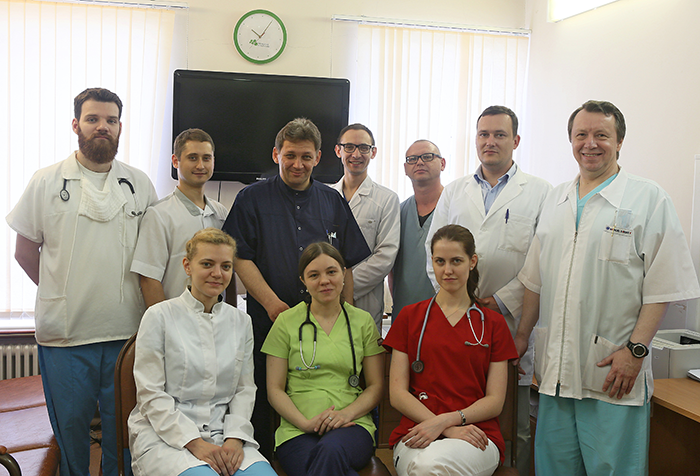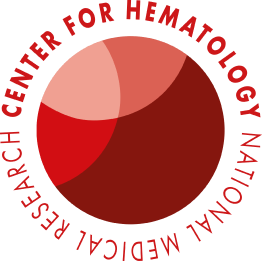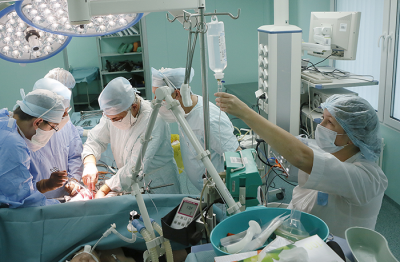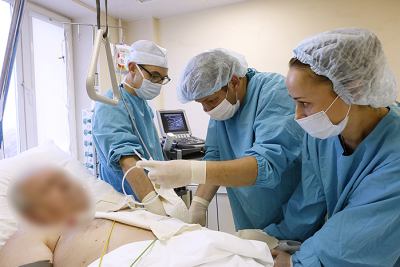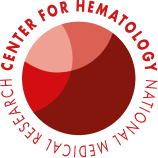
Head of the department- anesthesiologist—resuscitator, Gennady M. Galstyan, Doctor of Medical Sciences
The department is part of the Division of Resuscitation and Intensive Care.
Intensive care of patients with diseases of the blood system and the provision of anesthesia during surgical interventions in these patients is a new area of hematology and anesthesiology-resuscitation. Its birth is directly related to the success of modern program antitumor chemotherapy, which has made it possible to cure many tumor diseases of the blood system which were previously considered fatal. At the same time, modern antitumor chemotherapy was accompanied by an increase in the number of deadly complications, fraught with a possible lethal outcome before reaching a therapeutic effect. In one of the first analyzes of the effectiveness of artificial lung ventilation (ALV) in patients with hemoblastosis, it was found that their 6-month survival rate was 3%. Taking into account the low efficiency and high cost of treatment, high mortality, reaching 80-95%, the authors questioned the advisability of conducting intensive care in this group of patients - "not everything should be done that can be done." The first results of intensive care in hematological patients reinforced the impression of hopelessness: 100% mortality in septic shock and 100% mortality among patients transferred to mechanical ventilation. Patients with severe respiratory insufficiency, severe hypoxemia put off being transferred to a ventilator until the last moment, since tracheal intubation was associated with a death sentence. Catheterization of the central vein in a patient with acute leukemia with thrombocytopenia and hemorrhagic syndrome was considered contraindicated, its implementation was almost a feat, and puncture and catheterization of arterial vessels and invasive monitoring of central hemodynamics was out of the question. Today, it seems quite natural to the clinical resident of the Intensive Care Unit of the NMRC for Hematology that a patient in a state of agranulocytosis, with thrombocytopenia after a course of chemotherapy, who is undergoing inotropic support, must have invasively measured blood pressure, and dynamic monitoring of intrathoracic blood volumes, cardiac output, which is performed with prolonged mechanical ventilation tracheostomy, that such a patient should be in a separate resuscitation box-isolation. Today, the effectiveness of chemotherapy and long-term prognosis in patients with hemoblastosis who are on mechanical ventilation and the choice of chemotherapy tactics in a patient who has undergone septic shock in a state of agranulocytosis are being seriously discussed. 20 years ago, this seemed simply implausible.
In our country, the first specialized hematology beds in an intensive care unit were allocated at the Central Clinical Hospital No. 2 - the clinical base of the Department of Hematology of the Central Order of Lenin Institute of Advanced Medical Training, led by Acad. A.I. Vorobyov, at the end of 1977. A.E. Baranov, G.D. Selidovkin, and N.M. Nadezhina were among the first to conduct intensive care under aseptic conditions, when Clinical Hospital No. 6 of the Ministry of Health of the USSR was supplied with the first aseptic tents with a laminar flow - “islands life "(life islands), where the victims of the accident at the Chernobyl nuclear power plant were treated.
In 1989, V.G. Gorodetsky established the first fully specialized Department of Anesthesiology and Resuscitation in the Hematological Research Center headed by Academician A.I. Vorobyov. During the more than 20 years of its existence, the department has solidified its structure and basic principles of work. The department began with six beds located in one resuscitation room. However, it gradually became clear that isolation of intensive care patients with a hematological profile was necessary. Isolated beds began to be allocated, and the department increased to nine beds. Over the years, new successes have been achieved in the treatment of oncohematological patients, which made it possible to cure many tumor diseases of the blood system which were previously considered fatal (a vivid example is patients with acute promyelocytic leukemia). The increase in the effectiveness of treatment was achieved not only due to the increased aggressiveness of chemotherapy and the use of hematopoietic stem cell transplantation, but also due to the creation of a vascular access service (E.M. Shulutko), protocols for the management and control of various ventilation methods (V.G. Gorelov, A.V. Fedanov), and targeted diagnosis and therapy of acute respiratory failure, sepsis and septic shock (G.M. Galstyan).
In 2009, the department was reformed into a division consisting of two departments – The Department of Anesthesiology and Intensive Care and the Department of Intensive Care and Express Laboratory. In 2014, all of these units were merged into the Scientific and Clinical Department of Anesthesiology and Intensive Care and in 2022 the department became a part of the Division of Resuscitation and Intensive Care.
The Department of Resuscitation and Intensive Care of the NMRC for Hematology is the only specialized department in Russia designed to perform anesthesia and treat life-threatening conditions in patients with diseases of the blood system. The role of the department is to provide anesthesia during surgical interventions in patients with diseases of the blood system and hemostasis disorders, management of patients in the postoperative period, and intensive care in hematological patients. Currently, for 260-270 hematological patients receiving treatment at the NMRC for Hematology, there are a total of 15 beds (6% of the total bed fund of the Center) for intensive care.
During the year, an average of 900-1000 anesthesias are performed in the department for a variety of surgical interventions - neurosurgical operations, operations on the chest, abdominal cavity, moreover, performed under the conditions of both thoracotomy and laparotomy, and thoracoscopy and laparoscopy, with endovascular, orthopedic, urological, gynecological operations, and operative delivery in patients with diseases of the blood system. In order to achieve this, all operating rooms are equipped with modern anesthesia and respiratory apparatus, monitors.
Anesthesia in the operating room
The department has 15 beds, 9 of which are located in separate single-bed intensive care wards. Each ward is equipped with a monitor connected to the central station, as well as a video surveillance system, the information from which is transmitted to the nursing and medical posts and to the treatment room. In addition, to monitor patients in isolation, all rooms have viewing windows.
All wards provide the possibility of on-site renal replacement therapy (hemodialysis, hemodiafiltration). Each bed has a modern respirator that allows for respiratory support both in the form of non-invasive lung ventilation and traditional artificial lung ventilation. To transport patients around the Center (to the computed tomography room, operating room), there are 2 transport monitors, a LTV 1200 transport respirator ("Pulmonetic") and an oxygen cylinder on a trolley.The presence of a round-the-clock hemostasis laboratory, as well as an express laboratory, allows round-the-clock examination of patients.
All doctors of the department are proficient in the method of fiberoptic bronchoscopy. Annually, the department performs 700-800 fiberoptic bronchoscopies and about 120 bronchoalveolar lavage procedures. All doctors are knowledgeable in the technique of dilated tracheostomy.
The doctors of the department provide vascular access to all departments of the Center. The use of ultrasound navigation in the catheterization of veins and arteries avoids serious complications. An average of 1,400 catheters are installed per year, with not a single case of pneumothorax or hemothorax. In addition to short-term and medium-term catheters, catheters are also installed for long-term standing - a long-term implantable central venous catheter (PORT), a peripherally inserted central venous catheter (PICC), a long-term tunneled central venous catheter (Hickman/Leonard).
The department employs 9 anesthesiologists-resuscitators, 4 of whom are Candidates of Medical Sciences.
Doctor of Medical Sciences, G.M. Galstyan (in the center), nurse N.A. Pivneva Catheterization of the basilar vein under ultrasound control
Basic medical equipment: 18 ventilators (Vela, Servo-S. MAQUET, LTV 1200, Puritan-Bennet), 3 fiber bronchoscopes, 2 ultrasound machines, SCHILLER, Philips electrocardiographs, pacemaker, anesthesia breathing apparatus (Drager, Blease), perfusors, infusion pumps. coagulometers, aggregometers, gas analyzers, biochemical analyzers, luminometer (quantitative procalcitonin), Pathfast (presepsin studies), 5 TEG-500 thromboelastographs, ROTEM thromboelastometer, etc.
KEY EMPLOYEES
Olga K. Levchenko — anesthesiologist-resuscitator, Candidate of Medical Sciences
Stanislav A. Keselman - anesthesiologist-resuscitator, Candidate of medical Sciences
Polina M. Makarova — anesthesiologist-resuscitator, Candidate of Medical Sciences
Alexander Y. Mashkov - anesthesiologist- resuscitator
Olga V. Kulagina - senior nurse
